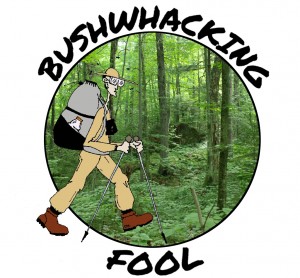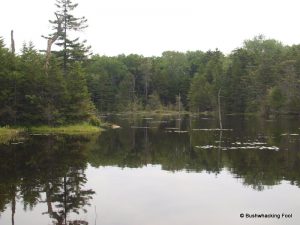
Largest Scattershot Pond
After passing both Elbow and Lost Island Ponds since leaving the Red Horse Trail, my next destination on the way to Negro Lake is a cluster of small unnamed ponds. Their location is just north of Negro’s outlet stream that has been my guide since leaving the marked trail behind at Witchhopple Pond. Cluster of unnamed ponds is too unwieldy a way of referencing them throughout my trip (and write-up), so I christen the four or five ponds Scattershot Ponds instead.
Scattershot Ponds is a fitting name as they resemble something like a scattershot from a shotgun, or at least as far as I know, as I am not much of a gun-nut. It seems odd that they were never given a name, as they are a significant feature, at least more than Elbow and Lost Island Ponds. Maybe the name will stick, though probably not.
As the beech-birch-maple overstory continues in the forest since soon after leaving the vicinity of Lost Island Pond, the understory slowly increases in thickness, with eventually scattered rocks joining in on the fun, making the going a little more treacherous than before. Witchhobble and young conifers not only increase the difficulty, but make careful foot placement a necessity to avoid getting caught in a concealed hole and spraining an ankle, or worse.
Section Stats:
Date: June 27, 2015
Length: 1.4 miles (5.0 total daily miles; 17.4 total trip miles)
Difficulty: Moderate
Sunlight begins to penetrate the canopy to the south at first, then shortly in front of me to the northeast as well. As conifers take on an increasingly dominate role in the surrounding forest, it seems likely that the long pond of the Scattershot Ponds is not far. Veering south, I try to get closer of the open water to take a few photographs and give myself a sense of its nature; unfortunately the conifers do not cooperate readily, closing in as to conceal the pond’s location.
When I get closer to the open water, I shed my backpack and proceed without it, hoping being less encumbered makes it easier to get up close and personal with the pond. The conifers continue to stymie my efforts as best they can however, but I finally get to a place where I can see the pond in all its glory. Although there is quite a bit of open water, much of the area has herbaceous vegetation growing from the saturated ground. The pattern of vegetation and a look at the map, suggests that more open water lies to the northeast, which should mean more views in my immediate future.
After retrieving my backpack, I continue northeast in an attempt to “thread the needle” through the Scattershot Ponds. A stream crossing soon follows, and then a small fern-dominated area appears to the south, apparently separating me from the long pond. With the mixed forest, it is clear I am never too far from the pond though, and within a few minutes, I can once again see the pond through the trees to the south.
Welcome back, old friend.
When a nice viewing possibility presents itself, I venture in for another look. As I thought, the open pond is long and significant, with a beaver lodge to the northeast and a conifer-covered ridge along its southeastern shoreline. Green frogs twang nearby, while an ovenbird sings its disapproval with my presence. To get some good views for photographing, I pace up and down the shoreline for a short distance, but I never find what I am looking for.
After continuing to the northeast again, I find a nice herd path just a short distance from shore back in the forest. The path takes me to a nice open area, with a scattering of large trees and almost no understory except for ferns and other herbaceous vegetation, which remains mostly below the knees. This would make a good campsite if I ever want to stay here on some other trip in the future.
The temptation to stop and indulge my inner photobug is too great, even so soon after doing so in the less ideal spot just a short time ago.
After exhausting my urge to photograph the pond, I retrieve my backpack and start my hike again. Before getting far, I notice something moving along the old dam in the northeast corner of the pond. The tawny shape moves slowly and cautiously, giving me ample time to identify it as a white-tailed deer. Seeing a deer in the area is kind of treat for me, so I watch it until it either hears me or catches my scent and soon disappears within the surrounding vegetation.
Just a short distance to the northeast, a water-filled channel stymies my progress. Since it is too wide and deep to ford, at least without getting wet and mud-covered, I choose to turn west following the channel along a densely conifer-covered ridge instead. Although not mountaintop dense, the conifers are dense enough to slow my pace and require extra care. So when a short dam gives me the opportunity to cross, I do so without hesitation.
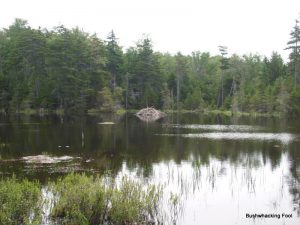
Second-largest Scattershot Pond
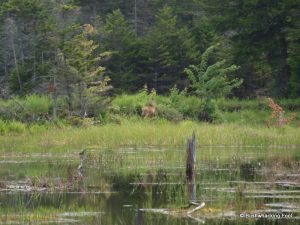
White-tailed Deer
At the far end of the dam, a boulder requires some navigation to get around. The boulder has ferns, grasses and other herbaceous vegetation covering, appearing like a head with luscious hair. A brown blur flies off the boulder from within a clump of vegetation, appearing as no more than a flash of tan as it disappears into the surrounding forest.
My nest-finding intuition takes over immediately, my eyes scanning the rock for a likely location for a ground nesting bird. It takes no time at all before I spot it within several fern clumps; a nest with three bright blue eggs. From what little I saw of the bird, the nest location and the egg color, my guess is it is a hermit thrush. With great haste, I take a few photographs and move on, so as to disturb the area as little as possible; mama thrush has work to do after all.
Reentering the forest, I get far enough away from the channel and then veer back toward where I would be had no detour been forced upon me by the stream. The forest has a hardwood feel to it now, even though some conifers remain in the surrounding understory. After crossing a small rocky stream, the forest takes on a more mature hardwood flavor, while in a short distance the largest of the scattershot ponds begins appearing to the south through the trees.

Probable Hermit Thrush Nest
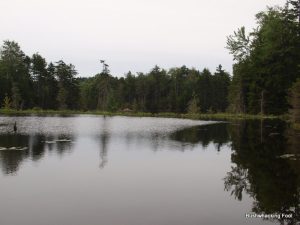
Largest Scattershot Pond Dam
As I approach the shoreline of the large pond, more conifers appear in the forest, a typical phenomenon for a small Adirondack waterbody. A large boulder along the shore attracts my attention, drawing me towards it as if it is a magnet to my metal. Two yellow birches stand on top of the large boulder, their thick roots covering a good portion of the rock surface, as if they grew everywhere in search of precious soil. It is a weird sight indeed, the fact that they still stand after all these years is a feat of strength to say the least.
Upon reaching this point, the photobug starts biting me again, so I pace up and down the shoreline searching for different vantage points for capturing an image of the large pond. In doing so, I notice how the current gray overcast sky contrasts with the sunny sky just a few hours before. The forecast of rain later in the day seems to have more merit now, giving me a renewed sense of haste to get going to Negro Lake once again.
With the photobug satiated for the moment after a few photographs, I return to bushwhacking with a new urgency, staying along the coniferous/broadleaf edge, since it provides the easiest going. The large pond is barely out of sight before sunlight once again pierces the clouds and canopy, much to my delight. The hardwoods soon start to dominate the forest once again, with many young beech trees making the going a little more difficult.
When crossing an open stream, with many crisscrossing logs and exposed rocks scattered about, a shrill sound emerges from the surrounding forest. The sound is highly distinctive and I recognize it immediately as a female ruffed grouse distress call, most likely due to me getting too close to her young. Though it sounds relatively near, the mother and her young evade my detection. Perhaps the young are too tiny to fly and my proximity fails to initiate the mother’s charging/feigning injury response, or maybe they scurried off before I got a chance to see them.
Young hardwood saplings again dominate on the other side of the stream as the terrain shifts to an incline as the last scattershot pond draws closer. Within minutes a long descent follows, which eventually leads to a more level area of mature forest with many ferns covering the forest floor.
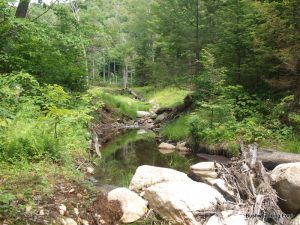
Stream from highest Scattershot Pond

Northeastern-most Scattershot Pond
As an open area appears to the south, I veer in that direction to check out the last pond. When I get to the shore, it turns out to be anti-climactic and disappointing. Although there is some open water, herbaceous vegetation clogs much of it, as if the pond is slowly transitioning into a wet meadow. The twanging call of the green frog permeates the quiet several times before leaving.
My departure from the pond is only temporary, as after a short bushwhacking stint within the surrounding coniferous forest, I am once again starring at an unimpressive pond. However, this time I spot a beaver lodge out in the open water, while nearby shrubs obscure much of the pond itself. Instead of dwelling on the view this time, I continue along the water’s edge but back in the forest a short distance, which has now become mostly hardwood.
With the Scattershot Ponds behind me, there is a long stretch of bushwhacking through almost uninterrupted forest before reaching the western end of Negro Lake. Once there, an old road is supposed to follow much of its northern shore. Until then, I am alone with my thoughts, a horde of biting flies, near-infinite number of trees and all the other denizens of the forest.
Lucky me!
Affiliate Disclaimer: Some links and advertisements on this blog post and elsewhere on the Bushwhacking Fool may send you to a retailer’s website. If you chose to purchase any product on that site, this author may receive a small commission at no extra cost to you. These commissions provide compensation for the author’s time and effort necessary to provide the content at the Bushwhacking Fool. If you enjoy the content on the Bushwhacking Fool, please show your appreciation by purchasing products through links and advertisements on this site.
